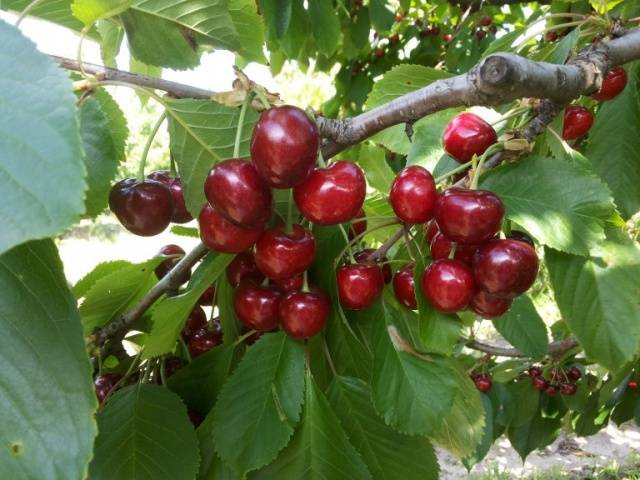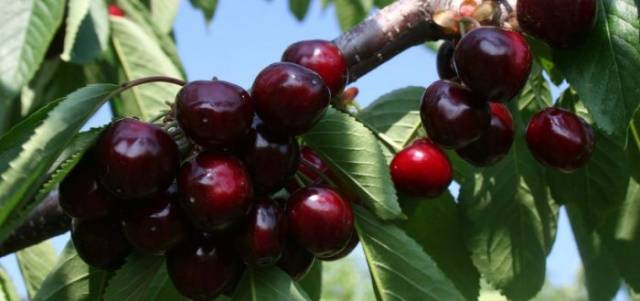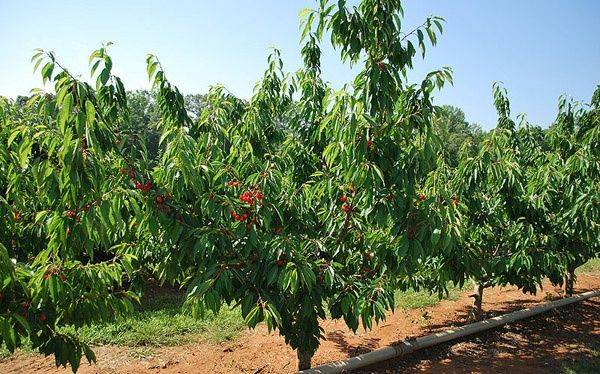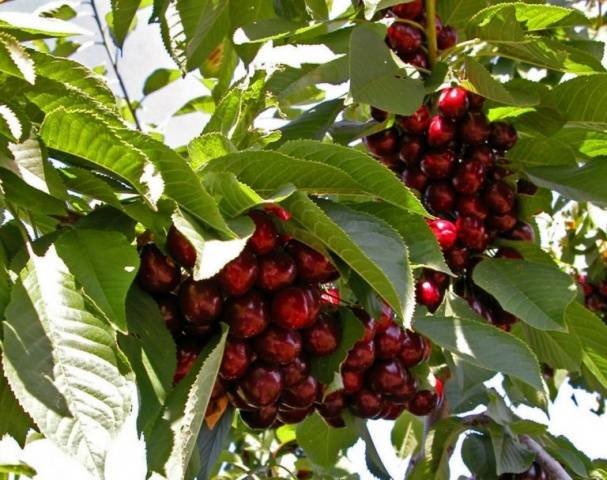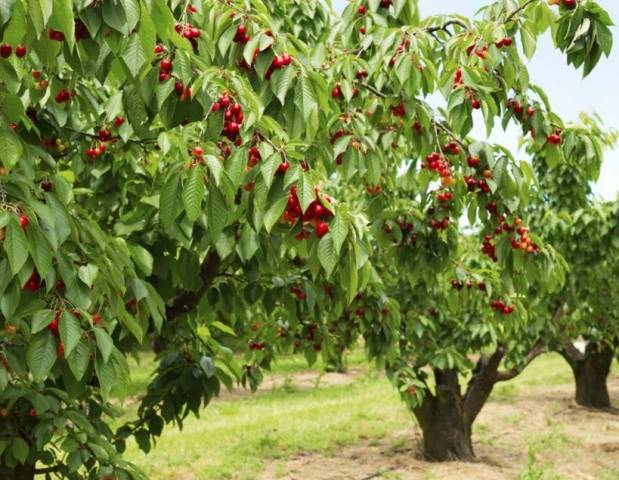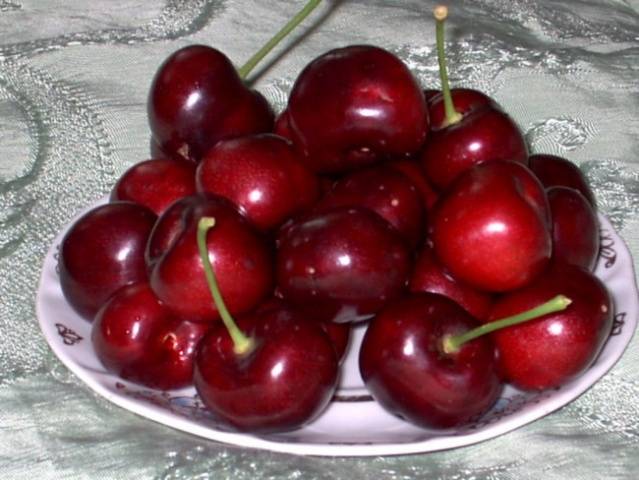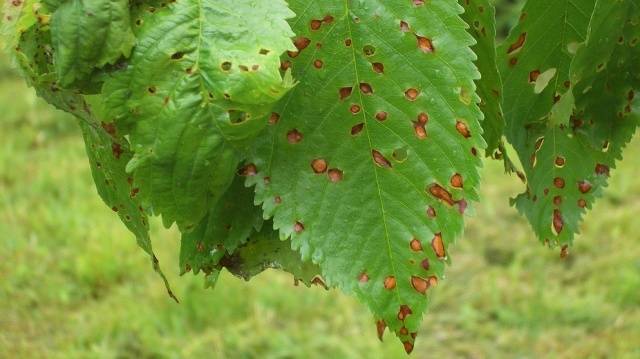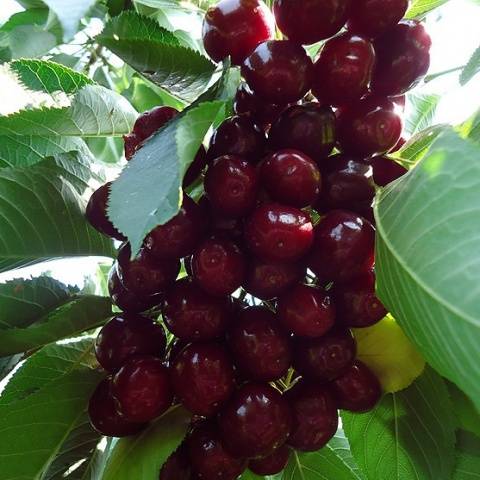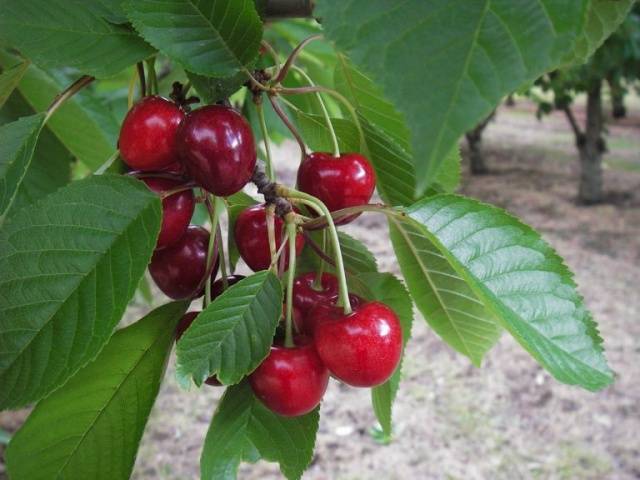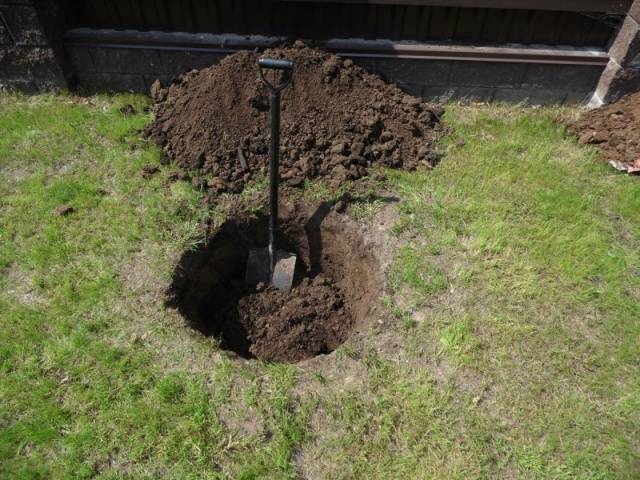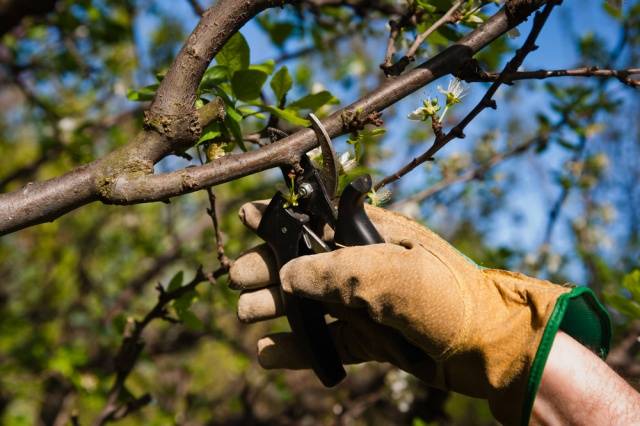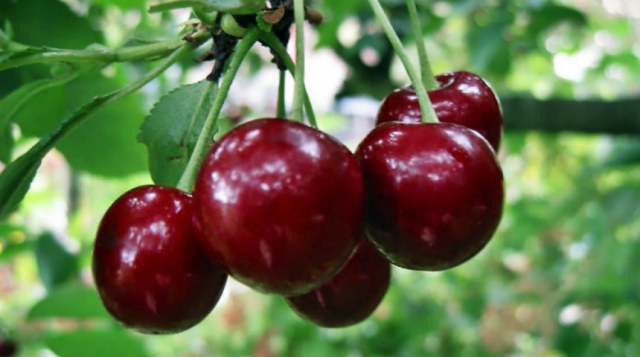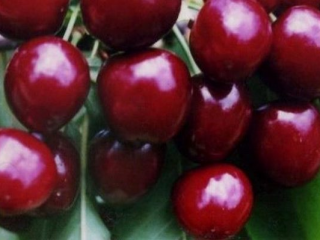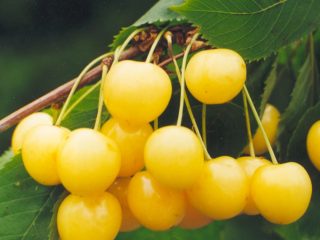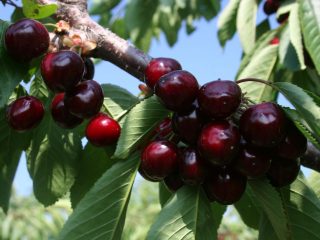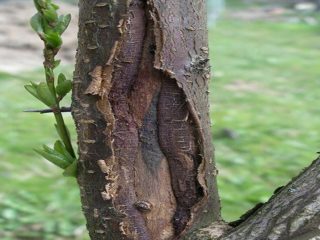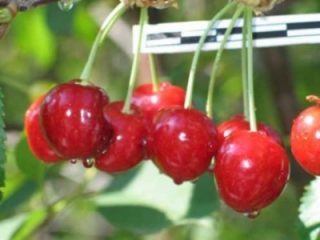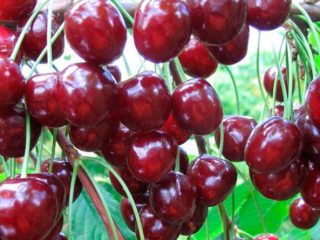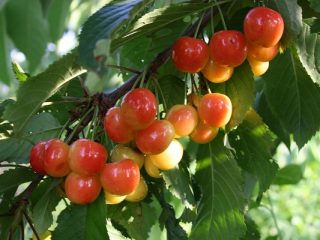Content
One of the most favorite plants of gardeners is the large-fruited cherry, which is a real record holder among trees of this species in terms of size and weight of fruits. Large-fruited cherries can be grown in almost any area, but first you need to study all its characteristics and features.
History of variety selection
For the first time this variety was bred on the territory of Ukraine - its originators are breeders M.T. Oratovsky and N.I. Turovtsev. The cherry variety Napoleon Belaya was used in the breeding work, and the Elton, Valery Chkalov and Zhabule varieties acted as pollinators. In 1973, the new variety was submitted for testing, and in 1983 it was entered into the State Register.
Description of the cherry variety Large-fruited
The large-fruited black cherry is a medium-sized tree that can grow up to 5 meters in height. The tree has few main skeletal branches, but they are very strong and covered with rough bark.
The natural shape of the crown is usually spherical, unless another is formed artificially, and of medium density. Cherry leaves are unremarkable - oblong in shape, slightly pointed at the ends, juicy green in color. The easiest way to recognize the tree is by its white flowers, which bloom thickly in April and envelop the entire crown of the cherry tree in a light veil.
A unique feature due to which the variety received its expressive name is the unusually massive cherry fruits. One berry can weigh from 10.4 to 12 g, sometimes even fruits weighing 18 g are found. The berries are round in shape, covered with thin but dense skin, the color of which can vary from rich red to almost black. The pulp also has the same color. In terms of ripening time, this variety belongs to the category of mid-ripening cherries - the fruits appear around mid-to-late June.
Ideal areas for growing large-fruited cherries are the southern regions, Crimea and Krasnodar Territory. However, the variety is successfully cultivated in the middle zone - it all depends on the quality of care for Large-fruited, on proper watering and pre-winter treatment of the plant.
Characteristics of the variety
In order to understand how suitable large-fruited cherries are for growing in a particular area, you need to carefully familiarize yourself with the characteristics of the variety. How well does the tree tolerate lack of moisture, frost and pests?
Drought resistance
This variety tolerates a lack of moisture quite well.On the hottest summer days, the cherry tree will require additional watering, but once a week with 50 liters of water is sufficient. The rest of the time, you can water the tree once a month in the amount of 20 - 40 liters of water under the trunk - this amount of moisture is enough for healthy growth of the cherry tree.
Frost resistance of large-fruited cherries
The variety was not created for negative temperatures, but tolerates them well. Winter cold in the middle zone, when the temperature drops to -25 degrees, does not harm an adult tree, especially if it is cared for. But young seedlings of the variety are sensitive to low temperatures - that is why it is recommended to plant Large-fruited cherries in spring and not in autumn.
Pollinators of cherry Large-fruited
Large black cherry is a self-sterile variety. This means that other varieties will need to be planted next to it, which will act as pollinators - only then will it be possible to get a bountiful harvest from the tree. For Krupnofrodnaya, pollinators can be:
- Cherry Francis — the variety blooms early, at the beginning of May, and ripening occurs by the end of June, approximately at the same time as the ripening of the Large-fruited cherry.
- Cherry Surprise — the variety begins to bloom in May, on the 5th – 10th. But the fruits from this variety can only be harvested by mid-July.
- Daiber Black Cherry — the variety blooms in the middle period, and its ripening is medium late. The fruits are usually harvested in late June - early July.
All of the listed varieties, planted next to Large-fruited cherries, can guarantee an abundant and high-quality harvest of the latter.
Productivity and fruiting
The description of the large-fruited black cherry variety suggests that the fruits of the plant ripen in the middle period, and the harvest appears in the second half of June. The tree does not begin to bear berries immediately, but only 3 years after the seedling is rooted in the garden.
As for the yield, the variety is simply amazing - one tree can produce up to 56 kg of fruit annually.
Area of application of berries
Large, fleshy, sweet and sour fruits of Large-fruited cherries have a high tasting score of 4.6 and can be used in a wide variety of culinary applications. The berries are eaten fresh, healthy juice is squeezed out of them, compotes and fruit drinks are made, and jam is prepared for the winter. Cherries can be used as an ingredient for baking.
Resistance to diseases and pests
The variety is considered highly resistant to damage from diseases and insects. However, with insufficient care and unfavorable weather, large-fruited cherries may be subject to some ailments. The most common diseases that affect cherries are:
- scab - expressed in the appearance of yellow spots on green leaves;
- moniliosis - drying out of young branches and ovaries;
- Clusterosporiasis — bright red spots appear on the leaves, fruit growth stops;
- gum therapy - the tree bark begins to exude resin, in which pathogenic bacteria settle.
The procedure for these lesions is approximately the same.Diseased areas of the tree are removed, and healthy areas are treated with antiseptics.
Of the pests that are especially dangerous to wood, aphids, weevils and cherry flies are especially dangerous. If insects are noticed on the leaves or fruits of the Large-fruited plant, it must be urgently treated with appropriate solutions.
Advantages and disadvantages of the variety
Large-fruited cherries have many more positive qualities than disadvantages. The advantages include:
- highest productivity;
- juicy and sweet taste of fruits;
- resistance to lack of moisture and low temperatures;
- resistance to pests and diseases that affect the tree very rarely;
- low maintenance requirements.
The downside of the variety is its sterility - pollinating varieties are required for abundant fruiting. Another drawback of the tree is its intolerance to high soil moisture - problems may arise with cherries during rainy seasons.
Planting and caring for large-fruited cherries
Large-fruited red cherry is a fairly undemanding variety in terms of external conditions. But you still need to know the basic rules of planting and care.
Recommended timing
Since young seedlings are very sensitive to cold, it is recommended to plant large-fruited cherries not in the fall, but in the spring - otherwise the shoots of the tree will simply freeze. Spring planting must be done on time - after the last frost, but before the beginning of the growing season for neighboring pollinator trees.
Choosing a suitable location
This variety loves the sun and warm air, so it is necessary to plant the tree in a well-lit area. The distance to the nearest trees should be about 3 meters.
The variety does not tolerate stagnant moisture, so swampy or clayey soil is not suitable for it.The tree favorably accepts loam and sandy loam soil with good ventilation capabilities.
What crops can and cannot be planted nearby?
It is not recommended to plant pears, apple trees and currants next to the tree. But other varieties of cherries and sour cherries can be planted in the neighborhood.
Selection and preparation of planting material
The root system of the planting material must be developed and intact, and a trace of the grafting must be visible on the trunk of the tree.
Landing algorithm
Planting a tree in the ground is carried out as follows:
- Prepare a hole - 2 times larger in volume than the size of the roots of the seedling.
- A layer of compost mixed with ordinary soil is placed at the bottom of the hole.
- The fertilizer is covered with soil on top and a peg is dug in for garter.
- A seedling is placed in the hole, spreading the roots over the soil layer.
- The earth is poured on top up to half of the hole, then a bucket of water is poured out and the earth is filled again - this time to the end. After this, the soil around the tree is compacted, watered again, and sprinkled with mulch.
Aftercare for cherries
Caring for large-fruited cherries does not require much effort from the gardener.
- You need to trim dry and damaged shoots, as well as ordinary branches that begin to compete with the main ones. Remove branches that grow below the skeletal branches. The shoots are shortened annually by a quarter or half.
- In dry weather, young trees are watered with 20–40 liters of water monthly; adult cherries require 40 to 60 liters of water. In case of drought, watering is carried out weekly, and in case of heavy rainfall it is stopped completely.
- In the first 3 years, the tree does not require any fertilizer.For the 3rd year, it is recommended to scatter ammonium and saltpeter under the trunk - no more than 25 g per square meter of soil. It is also recommended to scatter rotted manure near the trunk once every three years.
- The variety is resistant to diseases and harmful insects; the tree requires minimal protection. It will be useful to whiten the trunk with slaked lime.
- Before the onset of winter, it is recommended to dig up the soil a little, perform a final watering, and then cover the trunk with hay or spruce branches. Also, after leaf fall, cherries need to be sprayed with a superphosphate solution.
Diseases and pests, control and prevention measures
It is not recommended to unnecessarily treat large-fruited cherries with chemicals, since pests and diseases rarely attack them. As a preventative measure, it is enough to wrap the trunk with roofing material to protect it from rodents, and in winter, form a snowdrift around the trunk.
Toxic drugs are used only if the tree is really sick. To get rid of insects, Inta-Vir, Actellik and Decis solutions are used, and cuts and damage to the trunk and branches are treated with a solution of copper sulfate.
Conclusion
Large-fruited cherry is a fairly unpretentious fruit tree. If you follow the basic rules of pollination and care, the variety will delight you with very abundant harvests.
Reviews
